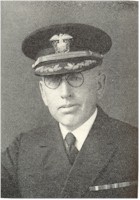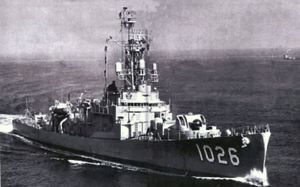Stanford Hooper: Difference between revisions
No edit summary |
No edit summary |
||
| (13 intermediate revisions by 5 users not shown) | |||
| Line 1: | Line 1: | ||
== | {{Biography | ||
|Image=Hooper.jpg | |||
|Birthdate=1884/08/16 | |||
|Birthplace=Colton, CA, USA | |||
|Death date=1955/04/06 | |||
|Associated organizations=US Navy | |||
|Fields of study=[[Radio]] | |||
|Awards=Marconi Medal of Honor; IRE Medal of Honor; | |||
}} | |||
[[Image:Uss hooper.jpg|thumb|right|The USS Hooper]] | |||
[[ | Admiral Stanford Caldwell Hooper was born in Colton, California, on 16 August 1884. His early education was received in the public schools of San Bernardino, California, and he worked as a relief [[Telegraph|telegraph]] operator during his summer vacations. In 1905, he graduated from the United States Naval Academy, and served on various naval vessels, having command of a destroyer during World War I. | ||
He instructed in electricity, physics, and chemistry at the Naval Academy from 1910 to 1911. From 1912 he served for two years as the first Fleet Radio Officer, resuming that post again from 1923 to 1925. For eleven years between 1914 and 1928 he was in charge of the Radio Division of the Navy Department, since then serving as Director of Naval Communications. | |||
Hooper was a leader in developing wireless [[Radio|radio]] communications in the Navy by carrying out pioneer tests, establishing a chain of land stations for communication between fleet and land, and serving as technical advisor and head of many boards and committees dealing with communications. He suggested the position of Fleet Radio Officer as necessary to the new radio Communications, and served in this post for two years. In World War I Hooper was awarded the Navy Cross for distinguished service as commanding officer of the U.S.S. Fairfax. | |||
After 38 years of military service, Hopper retired from the Navy in 1943 due to an injury incurred during World War II. Afterward, he was a consultant to electronic equipment manufacturers. | |||
The Franklin Institute of Philadelphia presented him the Eliot Cresson Medal for research in radio electronics in 1945. In 1948, Hooper received an honorary LL.D. from Drury College. He also received the French Legion of Honor, the Department of Navy Electronics Trophy, and is one of few to hold the Marconi Medal of Honor. | |||
Hooper received the [[IEEE Medal of Honor|IRE Medal of Honor]] in 1934 "For the orderly planning and systematic organization of radio communication in the Government Service with which he is associated, and the concomitant and resulting advances in the development of radio equipment and procedure." | |||
Admiral Hooper was married, to Margaret Nye Hooper, and had one daughter. He died at his winter home in Miami Beach on 6 April 1955. He was 70 years old. In recognition of his service, a Navy vessel was renamed the ''Hooper'' in 1956. | |||
== Further Reading == | |||
"S.C. Hooper Dead; Retired Admiral," ''New York Times'', Apr. 7, 1955. | |||
{{DEFAULTSORT:Hooper}} | |||
[[Category:Communications]] | |||
[[Category:Communication methods]] | |||
[[Category:Military_communication]] | [[Category:Military_communication]] | ||
Latest revision as of 18:08, 9 August 2017
- Birthdate
- 1884/08/16
- Birthplace
- Colton, CA, USA
- Death date
- 1955/04/06
- Associated organizations
- US Navy
- Fields of study
- Radio
- Awards
- Marconi Medal of Honor, IRE Medal of Honor
Biography
Admiral Stanford Caldwell Hooper was born in Colton, California, on 16 August 1884. His early education was received in the public schools of San Bernardino, California, and he worked as a relief telegraph operator during his summer vacations. In 1905, he graduated from the United States Naval Academy, and served on various naval vessels, having command of a destroyer during World War I.
He instructed in electricity, physics, and chemistry at the Naval Academy from 1910 to 1911. From 1912 he served for two years as the first Fleet Radio Officer, resuming that post again from 1923 to 1925. For eleven years between 1914 and 1928 he was in charge of the Radio Division of the Navy Department, since then serving as Director of Naval Communications.
Hooper was a leader in developing wireless radio communications in the Navy by carrying out pioneer tests, establishing a chain of land stations for communication between fleet and land, and serving as technical advisor and head of many boards and committees dealing with communications. He suggested the position of Fleet Radio Officer as necessary to the new radio Communications, and served in this post for two years. In World War I Hooper was awarded the Navy Cross for distinguished service as commanding officer of the U.S.S. Fairfax.
After 38 years of military service, Hopper retired from the Navy in 1943 due to an injury incurred during World War II. Afterward, he was a consultant to electronic equipment manufacturers.
The Franklin Institute of Philadelphia presented him the Eliot Cresson Medal for research in radio electronics in 1945. In 1948, Hooper received an honorary LL.D. from Drury College. He also received the French Legion of Honor, the Department of Navy Electronics Trophy, and is one of few to hold the Marconi Medal of Honor.
Hooper received the IRE Medal of Honor in 1934 "For the orderly planning and systematic organization of radio communication in the Government Service with which he is associated, and the concomitant and resulting advances in the development of radio equipment and procedure."
Admiral Hooper was married, to Margaret Nye Hooper, and had one daughter. He died at his winter home in Miami Beach on 6 April 1955. He was 70 years old. In recognition of his service, a Navy vessel was renamed the Hooper in 1956.
Further Reading
"S.C. Hooper Dead; Retired Admiral," New York Times, Apr. 7, 1955.

